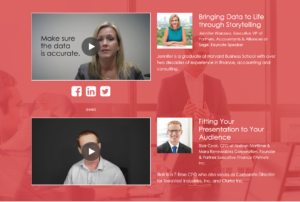
Is your content audience-centric?
“Of course it is!” Says the hypothetical person I just made up. “We do intensive research for all our content. We look at questions our audience is asking, we hit up SEMrush and BuzzSumo…our content is all about our audience!”

Here’s the big question:
Beyond learning about your brand, which will enrich their lives in many exciting ways, what is your consumer getting out of your content?
Creating or deepening a brand relationship can’t be the only reason your content exists. Raising brand awareness can’t be the only reason your content exists. That’s not audience-centric content. People will quickly realize that and move on.
Most marketers want to offer a genuine value exchange to our consumers. We’re not shriveled-hearted gargoyles trying to trick people into paying attention to us.
But it’s easy to think you’re putting the audience first, when it’s really the brand in the spotlight.
What follows are four questions that marketers commonly ask when creating content. These questions are crucial to content strategy — I’m not saying to throw them out. But let’s follow each one up with a question designed to center the content on the consumer.
Four New Questions to Ask for Audience-Centric Content
Make these new questions part of your content planning process, before you blog a single word or create a single promotional tweet. The answers will vary depending on your industry, your audience and their goals. It’s the asking that will help keep the balance between customer and brand-centered content.
1. Earning Attention
We Ask: “How can we get people’s attention?”
One of the fundamental challenges of modern content marketing is simply getting anyone to look at the content. People are distracted; every brand is creating content, and most of it is pretty good. Amplification is at least half of the battle for any content marketing.
We Should ALSO Ask: “How can we reward people’s attention?”
Note this is not the same as “what message about our brand should people take away from this content.” This is the promise your content makes to the consumer. What new skill, new idea, or more efficient way of polishing billiard balls are you giving them?
And yes, I know, this is content marketing 101 stuff. But it’s something that’s easy to lose sight of — the fundamental value exchange at the heart of content marketing. Make it part of your content planning. Add it to your template: “What promise are we making, and how are we fulfilling it?”
2. The Next Step
We Ask: “What action do we want people to take?”
Content marketing should inspire action. If we don’t know what next step we want people to take, we’re not marketing — we’re just publishing content for funsies. So this is a central question to content marketing that meets KPIs.
We Should ALSO Ask: “What action can we help people take?”
So a customer comes to your website, reads your latest asset, fills out a form, and gets on your mailing list. That’s a win for the brand. What constitutes a win for the customer? What is the next step in their personal development, professional development, or career path? How can your brand and your content help them take that next step?
For example: Our client Prophix, a finance software company, wanted to get the word out about their new PowerPoint integration functionality (brand goal). Together we helped address a bigger issue: Finance leaders need to give better presentations to have more influence in the company. We created a page where people can learn how to be better presenters. Instead of devoting the page to promoting Prophix’s new feature, we devoted it to making finance folks better at their jobs.
And here’s the kicker: All that audience-focused content led to stellar results for the brand goal, too.
3. The Purpose
We Ask: “How can we raise brand awareness?”
Familiarity with a brand is a big part of making a purchase decision. That’s especially true in B2B. Your family might take a chance on a new brand of soda, but your business likely wants a well-known, trusted name for a multi-million dollar purchase. For many of our clients, just getting their name in front of people, building awareness and credibility, is a big goal.
We Should ALSO Ask: “Why would people want to be aware of our brand?”
If you’re looking to establish a relationship with your customers, what are you bringing to that relationship? We can’t be the one who sits on the couch playing video games while the other person does all the cooking and cleaning.
What higher purpose makes your brand inspiring, uplifting, worthy of being aware of? Here’s your challenge: Write a secondary mission statement for the brand that doesn’t mention your product or service area at all. Before you try to raise awareness and build relationships, discover the values that will make your brand attractive.
4. The Long-Term Goals
We Ask, “How do we define success for our marketing efforts?”
Measurement and optimization are the building blocks of exceptional marketing. We should always have a clear idea of what success looks like to measure against and optimize toward. That means establishing KPIs, the metrics to measure them, and benchmarks to compare progress. We use a combination of industry benchmark results from campaigns with similar clients for comparison purposes.
We Should ALSO ask: “How do we define success for our audience?”
This question ties in with the purpose question. It requires your brand to have values beyond your product offering, values that reach out to customers even outside of their brand interactions. If your company truly prizes your customers and is dedicated to helping them succeed, what does that success look like?
Think about what your marketing would look like if you had as strategic a plan for your audience as you do for your business. “This content will help them look great in front of their boss. This campaign will help build the confidence they need to get promoted. This content will put them on the executive track.”
Imagine measuring your audience success along with your content’s KPIs. Of course, we may not go as far as to stalk people on LinkedIn to see if our content is helping them… but plan your content as though you were.
Audience-Centered Content Gets Results
You don’t have to choose whether your content will serve your marketing goals or the customer’s needs. Best-answer content that puts the customer first will do more for your marketing goals than the most aggressively promotional content you can imagine.
Most marketers start off with an audience-focused mindset. But it’s easy to get caught up in promotion, in moving people through the funnel, and lose sight of what value you’re offering consumers in return.
Before you start the next content planning session, take a step back, ask these new questions, and confirm that you’re focused on your audience, rather than asking your audience to focus on you.
Learn how audience-focused content helped the SAP App Center boost engagement by 116%.




